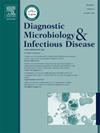Unraveling the Cryptosporidium Threat: Epidemiology, Genetic Diversity, and Prevalence in HIV-Positive Patients in Tehran, Iran
IF 2.1
4区 医学
Q3 INFECTIOUS DISEASES
Diagnostic microbiology and infectious disease
Pub Date : 2025-05-18
DOI:10.1016/j.diagmicrobio.2025.116918
引用次数: 0
Abstract
The primary objective of this study was to evaluate the prevalence and genetic diversity of Cryptosporidium infection in 100 HIV-positive patients. In addition, we aimed to investigate the risk factors and clinical outcomes associated with Cryptosporidium infection in patients with HIV in Iran. Moreover, the present study focused on assessing the relationship between Cryptosporidium infection and multiple factors, namely sociodemographic characteristics, clinical symptoms, medication intake, and immunological parameters. Clinical samples including nasopharyngeal (NP) swabs, induced sputum and stool specimens were collected from all patients, and routine clinical evaluations were performed. Three staining techniques were conducted to enhance diagnostic accuracy and determine the most sensitive method for detecting Cryptosporidium oocysts. The DNA recovery was optimized by freeze/thaw cycling, bead beating and sonication pretreatment. Among 100 patients, the presence of Cryptosporidium spp. was confirmed in 9 cases (9 stool, 3 sputum, and 3 NP samples), using the Nested PCR-RFLP technique. Two Cryptosporidium species were identified: 5 cases of Cryptosporidium hominis and 4 cases of Cryptosporidium parvum. The phylogenetic tree was constructed using sequencing data and was compared against genotypes available in GenBank. Data were analyzed using SPSS statistical software version 19 and analysis of variance (ANOVA test). We found that age, educational attainment, and adherence to treatment had significant relationships with opportunistic infections incidence (P < 0.01). Patients with HIV who had a CD4+ T cell count < 200 cells/µL were more susceptible to developing opportunistic infections (P < 0.001). Furthermore, HIV-positive patients with cryptosporidiosis exhibited significantly higher frequencies of weight loss and gastrointestinal symptoms.
解开隐孢子虫的威胁:流行病学,遗传多样性,和艾滋病病毒阳性患者在伊朗德黑兰的流行病学
本研究的主要目的是评估100例hiv阳性患者隐孢子虫感染的患病率和遗传多样性。此外,我们旨在调查伊朗HIV患者隐孢子虫感染相关的危险因素和临床结果。此外,本研究侧重于评估隐孢子虫感染与社会人口学特征、临床症状、药物摄入和免疫参数等多因素的关系。收集患者鼻咽拭子、诱导痰、粪便等临床标本,进行常规临床评价。采用三种染色技术提高隐孢子虫卵囊的诊断准确性,确定隐孢子虫卵囊最灵敏的检测方法。通过冻融循环、打头和超声预处理优化DNA恢复。使用巢式PCR-RFLP技术,在100例患者中,9例(粪便9例,痰3例,NP 3例)确认存在隐孢子虫。鉴定出2种隐孢子虫:人隐孢子虫5例,细小隐孢子虫4例。利用测序数据构建系统发育树,并与GenBank中的基因型进行比较。数据分析采用SPSS 19版统计软件,方差分析(ANOVA检验)。我们发现年龄、受教育程度和治疗依从性与机会性感染发生率有显著关系(P <;0.01)。CD4+ T细胞计数的HIV患者;200个细胞/µL更容易发生机会性感染(P <;0.001)。此外,hiv阳性的隐孢子虫病患者出现体重减轻和胃肠道症状的频率明显更高。
本文章由计算机程序翻译,如有差异,请以英文原文为准。
求助全文
约1分钟内获得全文
求助全文
来源期刊
CiteScore
5.30
自引率
3.40%
发文量
149
审稿时长
56 days
期刊介绍:
Diagnostic Microbiology and Infectious Disease keeps you informed of the latest developments in clinical microbiology and the diagnosis and treatment of infectious diseases. Packed with rigorously peer-reviewed articles and studies in bacteriology, immunology, immunoserology, infectious diseases, mycology, parasitology, and virology, the journal examines new procedures, unusual cases, controversial issues, and important new literature. Diagnostic Microbiology and Infectious Disease distinguished independent editorial board, consisting of experts from many medical specialties, ensures you extensive and authoritative coverage.

 求助内容:
求助内容: 应助结果提醒方式:
应助结果提醒方式:


